When putting together a trip to the Land of the Rising Sun, most travelers tend to go for hallmark destinations like Tokyo or Hokkaido. On my trip to Japan, I was blessed with an opportunity to explore a destination that seemed altogether more special. What followed was an incredible adventure in Japan’s underrated winter wonderland: Niigata. It was a beautiful place, filled with exciting family-friendly activities and attractions, dusted in a gorgeous blanket of snow. Read on to discover my journey!
Day 1
Narita to Tokyo
This was my first trip to Japan, and I was understandably nervous. After all, I didn’t speak the language; most of the Japanese I know comes from avidly watching various anime. The first leg of my Niigata itinerary involved getting from Narita to Echigo-Yuzawa Station, Niigata. Fortunately, it was pretty easy!
Once I landed at Narita Airport in Tokyo, I purchased a ticket for an Airport Bus that would take me to Tokyo Station. You’ll be able to find ticket counters at the Narita Airport terminals. This is the cheapest, and easiest way for newcomers to reach Tokyo from Narita Airport, only costing ¥1,300 (S$11.80). While waiting for the bus to arrive, which took roughly ten minutes, the first thing that hit me was the cold. It was a couple of degrees above freezing, but I found the chilly air to be rather refreshing.
The ride took about an hour and gave me plenty of time to see the landscape of Chiba and Tokyo bathed in the light of Japan’s winter sun. Once inside Tokyo Station, I found a JR East ticket station and purchased a Shinkansen ticket to Echigo Yuzawa Station. For travellers who are entering Japan via Tokyo as their first stop, Echigo-Yuzawa is an easily accessible winter getaway for three or four days.
Tokyo to Echigo-Yuzawa
Here’s an important tip when buying if you’re buying a Shinkansen ticket for the first time. Make sure to get a reserved seat, because it’ll give you room to store any large luggage bags that you might have with you. My ride to Echigo Yuzawa station cost me about ¥6,300 (S$57), which is pretty decent considering you’re journeying to a different prefecture. All in all, it was a splendid journey and the ride only took 70 minutes.
The real fun began when I arrived in Niigata, stepping off the train at Echigo Yuzawa station. The platform was lined with wide glass windows, and when I looked beyond them, my heart skipped a beat in pure delight. The quaint buildings of Yuzawa were blanketed in thick, fluffy sheets of snow.
Echigo-Yuzawa

Image credit: @jerry.p.97
I will always remember what it felt like to lay eyes on Echigo Yuzawa for the first time. After making my way to the station proper, I had two choices. Walk a little further to explore the various shops and restaurants within the station, or step outside. Naturally, I chose the more adventurous option. As the automatic doors of the station entrance slid open, I was greeted by a sight that took my breath away.

Image credit: @jerry.p.97
A mountain loomed in front of me, covered in dark alpine trees and glistening sheets of ice. The road ahead was lined with more snow and I couldn’t help but smile as I drew in a deep breath and my lungs tasted the fresh highland air. Beyond the snow, something else caught my eye. On the curb lay a low trough-like structure, built from marble and filled with steaming water.
Niigata is a region in Japan that is famous for its natural hot springs. When I placed my hand above the water, I felt slightly confused. Surely this couldn’t be the relaxing onsen that I heard so much about. (Later on, I would learn that such structures were footbaths, filled with natural hot spring water.)
Back at the station, my guides for the trip arrived soon enough; the earnest Aoki-san, and his companion, the charming Nakamura-san. They gave me a warm welcome, and after a brief discussion, the trip kicked off.
Yuzawa Kogen Ski Resort

Image credit: @jerry.p.97
Wasting no time, we made our way towards the Yuzawa Kogen Ski Resort, also known as the Yuzawa Kogen Ropeway. This was the first big stop on my Niigata itinerary. Echigo Yuzawa’s not a big place, and our destination was seven minutes from the train station on foot. Yuzawa Kogen Ski Resort is an incredible place for people looking to have fun with snow in all the best ways possible.
Before getting started, I would require the necessary outfit. Don’t worry about having to bring your own though. Yuzawa Kogen Ski Resort lets you rent everything that’s required at the front desk. After meeting the manager, I got to pick out a snowboarding outfit according to my size, and the colour I loved most. The resort launders every outfit after each use, so there are no worries about hygiene.
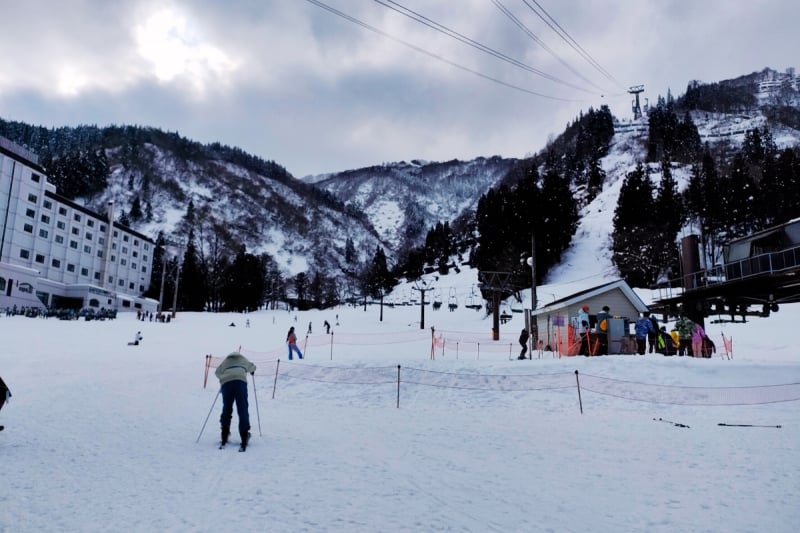
Image credit: @jerry.p.97
Aoki-san and Nakamura-san got similarly kitted out, and my winter adventure officially began. Naturally, I made a fantastic first impression on my Japanese hosts by falling flat on my behind the moment I stepped out into the snow. FYI, the stuff can get slippery. One good, hearty chuckle later, I was back on my feet and padding my way across the mountainside.
Snow activities at Yuzawa Kogen Ski Resort
Soon enough, we arrived at the main activity centre of the ski resort and got down to business. The first order of the day was snow-tubing. That’s basically when you sit in a giant inflatable tube and slide down a snowy slope. Don’t worry about hauling your tube up through the snow, because Yuzawa Kogen Ski Resort has a cool escalator that takes you right up to the designated station to slide down in your tube.

Image credit: @jerry.p.97
The ride picks up speed as you head down, and this brought back fond memories of going down slides in playgrounds when I was a kid. Besides that, I also got to try out sledding. Yuzawa Kogen provides a variety of modern sleds, including ones that are shaped like bicycles.
Now, you’re probably wondering why I didn’t try out any actual skiing or snowboarding. Well, that’s because the safety standards of this resort are incredibly high. They don’t let newbies without any training hit the slopes to avoid injuries. But if you’re an experienced skier or snowboarder, then Yuzawa Kogen should hold triple the appeal during your visit!

Image credit: @jerry.p.97
With my sledding extravaganza over, we headed towards Yuzawa Kogen’s renowned ski lift. It was a state-of-the-art structure, and massive to boot. According to the manager of Yuzawa Kogen, the lift can hold up to 160 people at any given time. The ride was smooth and I was treated to a spectacular view of the surrounding mountains, blanketed with snow.
Visiting Kumo Cafe

Image credit: @jerry.p.97
The ski lift glided to a smooth stop, and I found myself in a little annex with the peak of the mountain awaiting beyond. Here, we stopped for a bite to eat at Kumo Cafe. There was plenty to try, like edamame soup, pudding, panna cotta, and a fun beverage themed after the ski slopes. The spread was delicious, and exactly what I needed before heading back out into the cold. If the Yuzawa Kogen Ski Resort is part of your Niigata itinerary, I’d recommend visiting Kumo Cafe too.

Image credit: @jerry.p.97
Venturing outside after the meal, I once again found myself arrested by the beauty of Echigo Yuzawa in the winter. Mountains towered on the horizon, dusted with heavy snow and glowing the sunlight from a cloudless blue sky. My hours at Yuzawa Kogen Ski Resort were precious and simply unforgettable. It’s a fantastic destination for families looking for a fun romp in the snow, and seasoned pros seeking to sharpen their skills on the slopes.
On top of that, Yuzawa Kogen is connected to two other ski resorts occupying the same stretch of mountainside; the Gala Ski Slope and the Ishiuchi Ski Slope. These venues are bound together by a network of cableways and ski lifts known as the Yuzawa Snow Link.
Through this, visitors can start their day at Yuzawa Kogen and continue their journey across the mountain, enjoying different ski slopes along the way. There’s also a shuttle bus covering the three-kilometer distance between Yuzawa Kogen and Ishiuchi, which are the furthest apart from one another.
Yukemurinoyado Yuki-no-Hana Ryokan

Image credit: @jerry.p.97
My companions and I carried on toward our place of accommodation for the night: the Yukemurinoyado Yuki-no-Hana Ryokan. The hotel was just a five-minute walk away from the main entrance of the Yuzawa Kogen Ski Resort. A ryokan, of course, is a traditional Japanese inn that dates back to the 8th century, during the Keiun period of Japan.

Image credit: @jerry.p.97
The Yukemurinoyado Yuki-no-Hana blends traditional Japanese aesthetics and hospitality with the modern conveniences of present-day hotels. Upon entering, I was greeted by a lobby of dark wooden panels and blonde tatami mats. When entering a ryokan, it’s a respectful practice to take off your shoes and step backward onto a white cloth prepared by the host. According to Nakamura-san, this is done so that no impurities are brought into the hospitable environment of the inn.

Image credit: @jerry.p.97
My room had four single beds segregated into two individual spaces. The main sleeping area had a large window that allowed me to view the snowing landscape beyond. The second set of beds was sequestered beyond shoji doors, with a television and cosy lighting. The room was suitable for people travelling with their families. I was also provided with an extremely comfortable set of traditional Japanese loungewear called a samue.
My first Japanese onsen experience
After some rest, I continued my Niigata itinerary by trying out a popular attraction: the onsen. These natural hot springs originate from deep within the earth. The Yukemurinoyado Yuki-no-Hana comes with two different types of onsen experiences —Public onsen spaces separated according to gender, and three private onsen spaces with each bath tailored to a unique aesthetic.
Visiting Japanese onsen comes with a specific set of rules. For public baths, guests are required to be completely naked. Now, this might be a dealbreaker for a lot of people. But once you get over the fact, it’s a very relaxing experience. Fortunately, there’s a small towel that you can bring along to protect your modesty.
Before soaking in a hot spring bath, you’ll need to take a shower. The public onsen had neat and orderly stalls, partitioned on the sides and open at the back. After getting clean, the next step is simple. Bring the washcloth, find a suitable steaming pool to step into, and immerse yourself up to the shoulders in water.
Another aspect of the onsen tradition that must be followed is that you never let your towel touch the water around you. This is done for hygiene reasons. My first onsen experience was relaxing, serene, and invigorating. You can only sit in the water for 15 to 20 minutes before your body starts to sweat, and that’s a pretty good cue to exit.

Image credit: @jerry.p.97
Once I was done trying out the public onsen, I headed over to the private ones to give them a spin. The first room was elegant, with a round tub of dark wood filled to the brim with hot water.

Image credit: @jerry.p.97
The second room had the onsen bath cut from natural rock. Both chambers had shoji windows that opened into the cold mountain air. I felt a unique and wonderful sense of harmony from having my body soaked in hot water while my head stayed exposed to the cool mountain air.
Dinner at Yukemurinoyado Yuki-no-Hana

Image credit: @jerry.p.97
The first day of my Niigata itinerary came to a close with a splendid kaiseki dinner (a traditional Japanese multi-course meal). I was served fresh sashimi, cooked seafood that included fish and scallops, and a portion of shabu-shabu with fresh local vegetables and meat. There were also portions of the course that I could choose individually, and for those, I opted to try the beef tongue stew and a pork cutlet with rice.
With a hearty Japanese dinner in my belly, I spent the rest of my night staring out the window of my room, gazing at twinkling lights on a snowy night. And when my eyelids grew heavy, I slept soundly until morning light
Day 2
Yuzawa Strawberry Village

Image credit: @jerry.p.97
Breakfast was served early; a delectable selection of traditional Japanese eats ranging from fresh fruits to grilled fish. I also tried a unique dish called natto, which are fermented soybeans that are famous (or shall I say infamous?) for their slimy texture. Honestly, I thought they were rather delicious, and had no problem finishing my portion.

Image credit: @jerry.p.97
Our next destination on my Niigata itinerary was the Yuzawa Strawberry Village. This charming little strawberry farm is just 15 minutes from Echigo Yuzawa Station on foot, and only five minutes if you’re driving. The strawberries are grown in small greenhouses nestled in the snow.

Image credit: @jerry.p.97
Within, sunlight shimmered down through the transparent roof, and the air was filled with the sweet scent of ripe strawberries. Amidst rows of green plants, they dangled like shining rubies. These cultivated strawberries are called Echigohime. Echigo is the older name for the Niigata prefecture, and the term hime means princess.
The farm’s manager explained that we were visiting during the off-season. During peak season, Yuzawa Strawberry Village operates on an all-you-can-eat basis, since the strawberries are plentiful. Today, however, we would have to be content with picking our fruit and paying for them according to their weight.

Image credit: @jerry.p.97
The manager also informed us that the strawberries tend to naturally shrink a little during the peak harvest season. The ones we were about to pick today, on the other hand, were massive.
After filling our little baskets with big, juicy strawberries, we paid our dues at the counter before taking the freshly harvested fruit to a little side table to eat.
Every fruit I bit into was perfectly juicy, fresh, and laced with a natural sweetness that made me want to reach for another. Yuzawa Strawberry Village is a must-visit in Niigata prefecture, especially if you’re travelling with family. The best times to come and pick the Echigohime strawberries would be from mid-January to late June each year.
Ganya Ramen

Image credit: @jerry.p.97
My Niigata itinerary continued a classic Japanese ramen experience at Ganya Ramen in Echigo-Yuzawa Station. This modest restaurant is a popular spot for locals and tourists to grab a hot meal. I tried the miso ramen with hot soybean paste and ramen served with sake lees. Lees are the compressed by-product left over from sake production and are highly nutritious. It gave the miso broth a distinct flavour and I thoroughly enjoyed it.
Atema Kogen Resort Belnatio
If you’re travelling around Niigata without a rental car, there’s a shuttle bus from Echigo Yuzawa Station that can ferry you to the Atema Kogen Resort Belnatio. This was the next major destination on my Niigata itinerary. Contrary to the ryokan I stayed in previously, the Belnatio carried heavy Western influences in its design, with a large open gable roof on the main building that brought about classic ski lodge vibes.
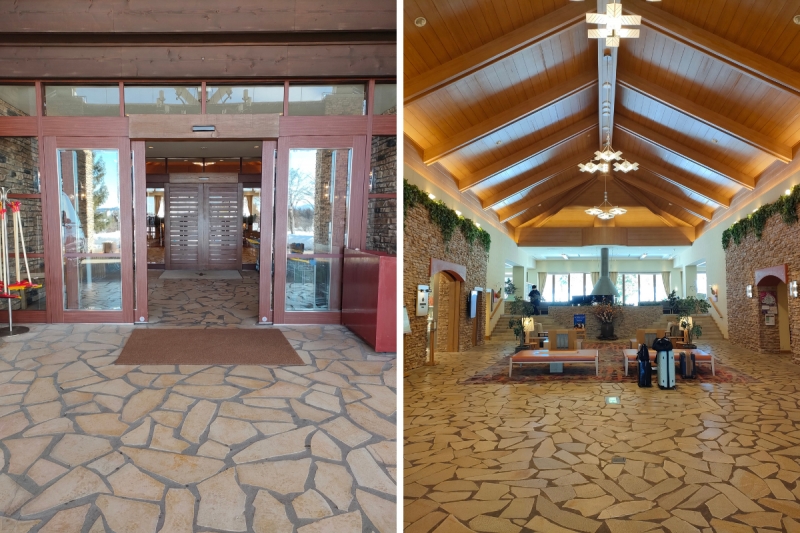
Image credit: @jerry.p.97
The interior spaces were suitably stylish and impressive, but the true allure of my time at the Belnatio came from its snow activities.
Snowland Forest Fairy Land
At the basement level of the hotel, a colourful doorway marked the entrance to the Snowland Forest Fairy Land. Beyond it, I was greeted by another enchanting landscape of soft, white snow. Unlike Yuzawa Kogen however, the slopes and lay of the land in general were wider and less steep. That’s mostly because, in the springtime, this very same landscape doubles as a golf course. For guests who don’t have their snow or ski outfits, the Belnatio provides a rental service.

Image credit: @jerry.p.97
You’ll need tokens to participate in the snow activities. These can be purchased at an admissions counter. I eagerly awaited as Aoki-san procured some so that we could try out our first activity; snow rafting. This is exactly what it sounds like, by the way. A giant yellow raft is attached to a high-powered snowmobile, which pulls it around the snow as it follows a trail through the hills.

Image credit: @jerry.p.97
It was an exhilarating experience, especially since I opted to sit in the back, and could feel every motion of the raft as it slid through the snow. The driver made exciting sharp turns along the way, showering me with ice as the raft collided with snowbanks on opposite sides of the trail. The ride lasted roughly seven minutes, and it was a thrilling time.

Image credit: @jerry.p.97
Next, I took on a familiar activity: tubing! The Belnatio provides an ingenious pulley system that allows you to sit in your tube before a hook snags it from the side and slowly pulls you up a snowy slope. Once I was at the top, I could see that the slide down would be steeper and faster than my experience at Yuzawa Kogen. Fortunately, staff members waited at every station to ensure every step of the ride went smoothly.
I sat down in my tube at the starting line and braced myself as a staff member sent me hurtling down the slope at full speed. It was a pure, icy adrenaline rush that I’ll always remember. As it turns out, sliding down a snowy hill never really gets old, no matter how many times you do it.
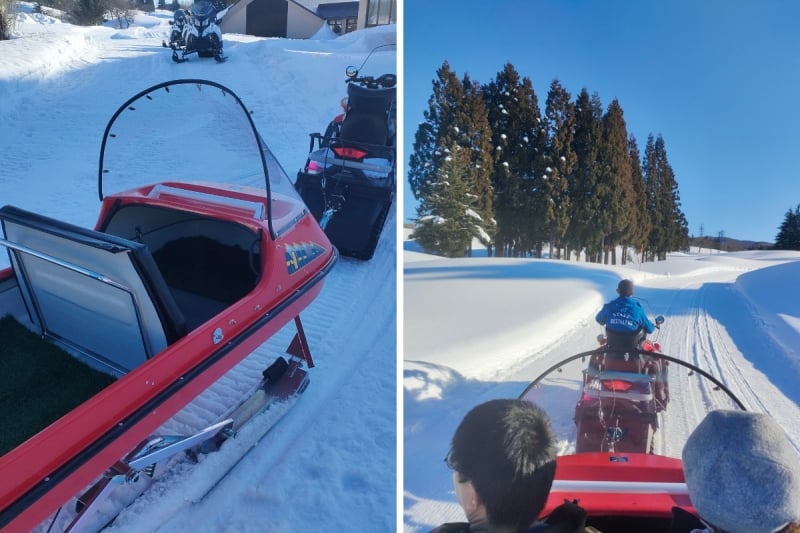
Image credit: @jerry.p.97
Finally, the last activity for the day turned out to be a perfect counter to all the previous tubing excitement. The three of us were taken on a scenic ride through the snowy landscape, a perfect opportunity to grab some pictures for the ‘Gram.

Image credit: @jerry.p.97
Once we reached the end of the trail, our driver stopped for a moment. I was given the chance to step down for a moment and walk across the newly fallen snow on the hilltop around me.

Image credit: @jerry.p.97
The scenic snow ride marked the end of the day’s activities. If you’re planning to visit the Atema Kogen Belnatio Resort, make sure to try their snow activities as part of your Niigata winter itinerary. Soon after, I retired to my room for a few moments of relaxation. Like the rest of the Belnatio, my room had a mostly Western influence.

Image credit: @jerry.p.97
However, there was also a tatami section on the far end, complete with a shoji cabinet holding futon beds.

Image credit: @jerry.p.97
Beyond the window, I could see the unique architecture of the Belnatio’s in-house chapel and event space, surrounded by a snowy landscape.
Dinner at the Atema Kogen Resort Belnatio

Image credit: @jerry.p.97
Dinner was at a stunning dining venue named Restaurant Cosmos. True to its name, the food was simply out of this world. I was spoilt for choice between a delicious spread of Japanese and Western cuisine alike.
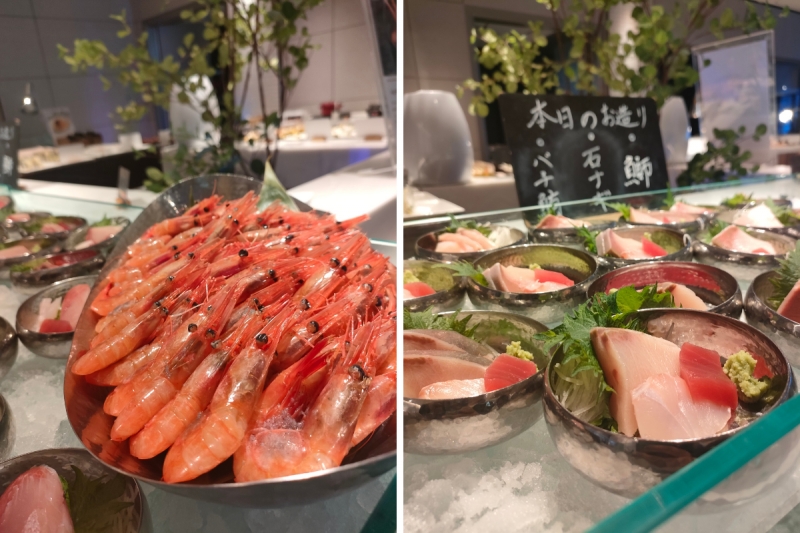
Image credit: @jerry.p.97
The sashimi was fresh, the sushi was hand-rolled before my eyes, and the steaks were cooked to a perfect medium rare. Also, I got to try a popular Japanese dish that I’ve never had before; shrimp with mayo.
Once dinner was over, I took a moment to rest in my room before heading to the Belnatio’s onsen facilities. This time, I ignored the conventional indoor pools and decided to try the outdoor onsen instead. Soaking in a steaming pool of hot water while being exposed to frigid winter air was truly refreshing.

The Atema Onsen in spring season. | Image credit: Atema Kogen Resort Belnatio Official Website
In Japan, this experience is referred to as Yukimi-buro, which roughly translates to watching the snow around you as you soak in a hot bath. This time, I was alone, which allowed me to enjoy the relaxing atmosphere even more. It was an incredible way to conclude my stay at the Atema Kogen Resort Belnatio and another must-try activity for any Niigata winter itinerary.
Day 3
Kiyotsu Gorge

Image credit: @jerry.p.97
At sunrise, I filled my tummy at the Belnatio’s hearty breakfast buffet before heading out. The next destination on my Niigata itinerary was Kiyotsu Gorge, one of the most popular destinations in the prefecture.

Image credit: @jerry.p.97
It was roughly a 20-minute drive from the Belnatio to Kiyotsu Gorge. When we arrived, I was treated to the gorgeous view of a rushing mountain river, winding its way through the icy cliffs at the tail-end of the ravine.
The Tunnel of Light
The entrance was a wide, concrete arch that led deep into the underground tunnel ahead. With Aoki-san and Nakamura-san at my side, we took our first steps toward Kiyotsu Gorge. In wonder, I watched as the tunnel around me transformed, lit by an acid-green hue brought upon by lights in the ceiling. Nakamura-san informed me that the journey through Kiyotsu Gorge was constructed as an art piece for the Echigo-Tsumari Art Triennale.

The Tunnel of Light | Image credit: MAD Architects, @jerry.p.97
Held once every three years, this massive art festival invites artists and creatives from around the world to construct permanent works of art to be displayed across the Niigata province.
The Kiyotsu Gorge experience was created by the Chinese architectural firm Ma Yansong/MAD Architects during the 2018 Echigo-Tsumari Art Triennale with the title: Tunnel of Light. From its emerald tint, I marvelled as the colours of the tunnel changed as I continued to walk, cycling through shades of yellow, orange, crimson, and icy blue.

Image credit: MAD Architects, @jerry.p.97
On my way down, I also passed by other individual art pieces that were part of the Tunnel of Light experience. These included a capsule-shaped bathroom that mirrored the curves of the tunnel around it and an arcing space filled with more round mirrors.
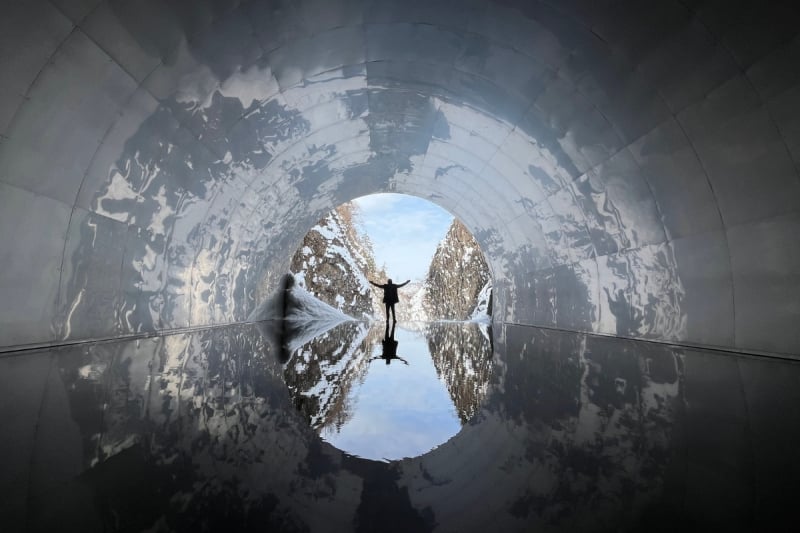
Image credit: MAD Architects, @jerry.p.97
As the path came to a close, the tunnel opened into a massive, semi-circular space filled with mirrored materials. Beyond it lay the yawning space of Kiyotsu Gorge, blanketed with ice and alpine trees. The view of the gorge was reflected in a shallow pool of water, creating a harmonious, snowy circle.

Image credit: @jerry.p.97
Leaning out from the edge, I could once again see the roaring river at the base of the gorge, a shifting column of cobalt blue that split into small crests of whitewater.
It was a truly memorable sight and a fantastic spot for taking Instagram-friendly pictures. Another interesting aspect of the gorge that caught my attention was the hexagonal columns of weather rock that made up the cliffside on either side of Kiyotsu Gorge. These were columnar jointed rocks, formed from volcanic activity that most likely rocked the landscape thousands of years ago.
Ikote Restaurant
Trekking up and down the Tunnel of Light to see Kiyotsu Gorge had only taken about 45 minutes in total. It wasn’t a strenuous affair, but that didn’t mean I wasn’t hungry. Fortunately, Aoki-san knew exactly where to take us for a bite to eat before we continued our Niigata itinerary.

Image credit: @jerry.p.97
Ikote is a unique restaurant that occupies an unassuming space on the pristine streets of Tokamachi City. We drove there, but it is also easily accessible via public transport. From the Belnatio Hotel, you can book a seat on a bus that will take you to Tokamachi Station. Ikote is just a 10-minute walk away from the station.
At first glance, Ikote looks like a creative cross between an antique barn and an airport hangar. This comes as little surprise, considering the entire restaurant is an art piece left behind to flourish from a previous season of the Echigo-Tsumari Art Triennale.

Image credit: @jerry.p.97
We sat down at a low table, in traditional seiza fashion. The ambiance was warm and cosy, a welcome respite from the cold outside. The menu at Ikote was varied and to my hungry eyes, everything looked good.

Image credit: @jerry.p.97
Luckily, I received an excellent recommendation to try the sharing platter from two local high school girls seated adjacent to us. As a result, I got to dig into braised pork, juicy kaarage, pork cutlets, local seasonal vegetables, and excellent miso soup. For a hearty meal in Tokamachi City, add a visit to Ikote to your Niigata itinerary.
Matsunoyama Onsen

Image credit: @jerry.p.97
Matsunoyama is the kind of town that you’d see in a classic Studio Ghibli movie and needs to be part of your Niigata winter itinerary. It’s a place so idyllic and picturesque that it almost seems you’re dreaming. That’s exactly how I felt when Aoki-san pulled the car over outside the Hinanoyado Chitose, a charming ryokan perched by the side of Matsunoyama’s only main street.
Aside from reaching our destination by car, visitors can also take a 10-minute train from Tokamachi Station to Matsudai Station. From Matsudai Station, a car is required to travel the rest of the way. However, some ryokans in Matsunoyama provide transportation to and from Matsudai Station, as long as they’re arranged in advance.
Hinanoyado Chitose

Image credit: @jerry.p.97
My room at the Hinanoyado Chitose was a pleasing combination of Japanese heritage, modern luxury, and small-town cosiness. I was quickly coming to the realisation that I loved Japanese architecture, from the bright tatami floors to the wide shoji windows. The beds were soft, and overall, the space was warm and welcoming.

Image credit: @jerry.p.97
The best part about the room was that it came built-in with an onsen. Hot water, hotter than my previous experiences, trickled into a wooden tub in a space open to the snowy landscape outside.
Fun fact; Maysunoyama Onsen ranks among the top three great medicinal hot springs in Japan. At its source, the temperature of the water can reach up to 92℃. The onsen is said to originate from seawater that was trapped below the ground more than 100 million years ago. This water is rich in minerals, containing up to 15 times the amount compared to a regular onsen, and is said to be great for the skin.
Exploring Matsunoyama

Image credit: @jerry.p.97
I started my evening by taking on Matsunoyama on foot. We passed by plenty of ryokan offering onsen services as we strolled down the picturesque main street.

Image credit: @jerry.p.97
Here, I got to partake in another unique experience at the Jiro Ashiyu. This is a public footbath located outside an ancient-looking building that functioned as a local community centre. It was a pretty cool experience to soak my aching feet while enjoying the cold, quiet air of the town. Keep an eye out for this while living out your Niigata itinerary!

Outdoor Onsen at Hinanoyado Chitose | Image credit: @jerry.p.97
Before dinner was served, I took an opportunity to enjoy another Yukimi-buro onsen experience in the snow. The onsen water seemed denser and was laced with the faint scent of sulfur and minerals. Soaking in that water helped fire up my appetite, and I was ready to take on any delectable treats that the inn could dish out.
Hinanoyado Chitose

Image credit: @jerry.p.97

Image credit: @jerry.p.97
Fortunately, there were plenty to enjoy. A variety of dishes were served ranging from fresh sashimi and sweet sasadango (rice dumplings) to fragrant kuromoji tea.

Image credit: @jerry.p.97
There was also pork cooked in the hot springs of Matsunoyama for over three hours. Finally, let’s not forget that delicious Koshihikari Rice, steamed to perfection by the heat of the antique stoves.
This was the tail-end of my Niigata itinerary, and I was due to fly back home the next day. When I returned to the room after dinner, I stepped into the private onsen of my room and enjoyed one final soak in the hot spring. It was incredible.
Day 4
Bijin Bayashi Forest
The next morning, we checked out of the Hinanoyado Chitose early to head to the next destination on my Niigata winter itinerary: the Bijin Bayashi Forest. But first, I had to change into a set of snow clothes, rented from the inn. It was a 15-minute drive from the inn, and when we arrived at the forest, I was amazed at the sheer density of the snow around me. It was thicker here than any other place I had seen in Niigata.

Image credit: @jerry.p.97
The snow in the Bijin Bayashi forest averages upwards of two metres in the winter, so walking with regular footwear is pretty much impossible.

Image credit: @jerry.p.97
Snowshoeing in the forest
Snowshoes on and walking sticks in hand, we were given a quick tutorial on navigating the snow by our guide. At the forest entrance, our guide pointed out two enormous Japanese cedar trees, which were roughly 200 years of age. He explained that cedar was a prized material in building traditional Japanese homes, used for the framework and the supporting beams in ceilings.

Image credit: @jerry.p.97
Beyond the cedar grove, it was a short hike through the snow to reach the main attraction; rows and rows of slender beech trees that stretched out as far as my eyes could see. The name “Bijin Bayashi” roughly translates to “Beautiful Woman”. This evocative moniker comes from the fact that the beech trees of the forest are tall and slender, which seems to meet the epitome of Japanese beauty standards.
The trees had been planted more than a hundred years ago, after a local purchased the land to restore it from a previous deforestation incident. Beech trees are also prized as a material for building in Japan due to the natural flexibility of the wood.

Image credit: @jerry.p.97
Among the many interesting things our guide showed us in the Bijin Bayashi Forest were fresh rabbit tracks in the snow, beech flower buds, and beech nuts. The nuts are edible after being peeled. I got to try some and they tasted rather pleasant. The best way to describe the flavour is a curious mix of almonds and walnut.

Image credit: @jerry.p.97
We also came across a semi-frozen pond in the middle of the water, filled with icy cold water from the surrounding snowmelt. According to our guide, a special channel runs from the pond in the forest, taking fresh water down the hills to homes and farms in the lowlands.
He spoke passionately about how Japanese people have learned to rely on and deeply respect their natural environment, a practice that came to the fore while their ancestors toiled to tame the land thousands of years past.
An irori experience

Image credit: @jerry.p.97
The tour of Bijin Bayashi forest came to an end soon after. We retreated indoors and sat by an irori, a traditional Japanese sunken hearth.
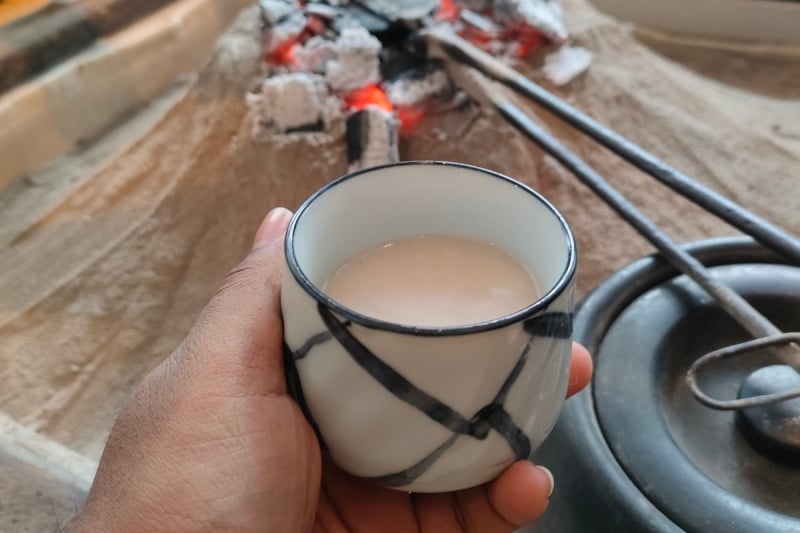
Image credit: @jerry.p.97
Our guide then served us some amazake, a form of sake that’s thicker, sweet, and non-alcoholic. The taste was fantastic, with a combination of milky and malty overtones that were entirely new to my tastebuds. Resting at the hearth marked the end of my experience at the Bijin Bayashi forest. It was now time for me to begin my journey home.
Ponshukan

Image credit: @jerry.p.97
We travelled back to Echigo-Yuzawa Station to wrap up my Niigata itinerary with a bunch of truly explosive proportions. Within the station, there is a souvenir section called Ponshukan which sells unique local items from every part of the Niigata prefecture. These include various foods, clothes, kitchenware, and sake.
Bakudan Onigiri-Ya
At Ponshukan, we entered a tiny dining area called Bakudan Onigiri-Ya and made a truly enormous lunch order; the Big Bomb Onigiri.

Image credit: @jerry.p.97
This was an onigiri the size of a man’s head! It’s made with eight bowls of rice, and you can choose up to five different fillings for this gargantuan orb. Our onigiri was stuffed with pork, pickled vegetables, and salted pickled plums called umeboshi. Cutting into it felt like carving a cake, and we were each left with an enormous chunk of food to finish.
I managed to eat my fill and even went back for seconds. It was a delicious and magnificent meal to end my final day in Niigata. The Bakudan Onigiri-Ya even has an eating challenge for people willing to go solo on the Big Bomb Onigiri. Thankfully, that momentous feat wasn’t part of my afternoon. Trying out this massive meal should definitely be part of your Niigata itinerary.
Kikizake Bansho

Image credit: @jerry.p.97
Finally, we visited Kikizake Bansho, which is like Echigo-Yuzawa’s sake museum. It is perhaps the most celebrated attraction to check out here.

Image credit: @jerry.p.97
Here’s how it works. You step inside a little enclave and exchange ¥500 for five tokens. On the far wall, you’ll see what looks like little lockers at first glance. But no, these are sake vending machines.

Image credit: @jerry.p.97
Each dispenses a sake from a brewery in Niigata, and there are 129 machines to sample from! Luckily, Aoki-san was content to let me try just five of them.

Image credit: @jerry.p.97
I don’t claim to be a sake connoisseur, but every cup I had was smooth, fresh, and clean. Kikizake Bansho needs to be part of your Niigata itinerary if you’re visiting Echigo-Yuzawa. With that, my odyssey in the winter wonderland of Niigata finally came to a close. I bid a fond farewell to Aoki-san and Nakamura-san, chuckling at their fervent insisting that I return soon.
My final thoughts
Saying that my Niigata itinerary was memorable and fun would be an understatement. It was a life-changing, eye-opening experience that extended far beyond what I expected. Despite having travelled by car, it’s great to know that the destinations I visited are accessible through public transportation or convenient shuttle services.
Niigata does a winter itinerary exceedingly well, especially for family travel. It’s a wonderful place to enjoy the magic of snow without having to journey far from Singapore. Visiting Niigata in the winter reveals a new and exciting side of Japan that you will remember for the rest of your life.
Thank you Niigata Prefecture Tourism Organization for the wonderful trip.
All images are credited to Jeremiah Patrick unless otherwise stated.





